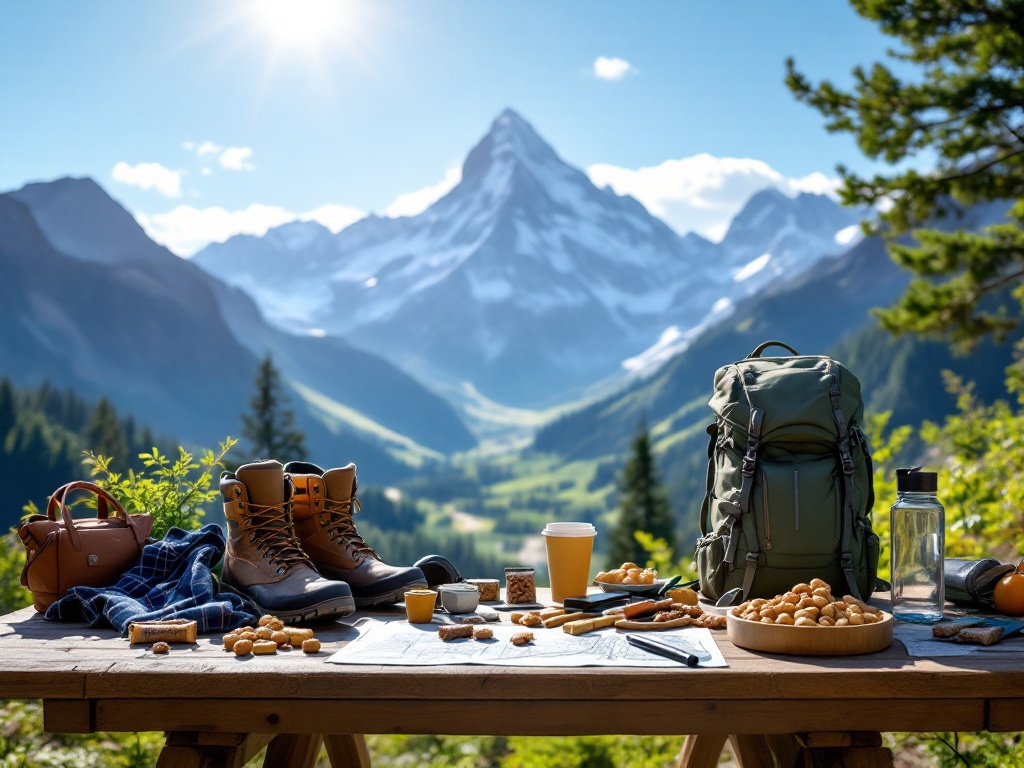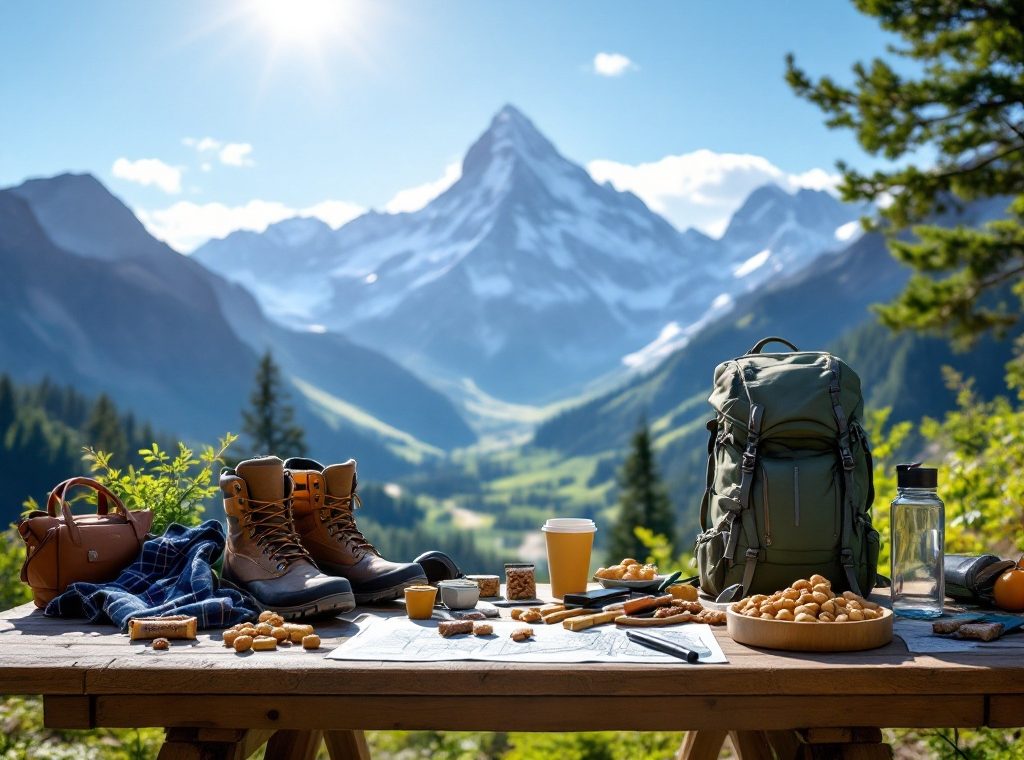How to Prepare for the Mountain Trip Abroad
Dreaming of a mountain adventure abroad? Proper planning is key to a safe and unforgettable trip. This guide provides essential steps, from researching your destination and choosing the right gear to understanding trail markings and mastering mountain etiquette. Learn how to prepare for high altitudes, pack essential snacks, navigate unpredictable weather, and ensure your physical fitness is up to the challenge. Start planning your dream mountain escape today!
Important information

- Research your destination thoroughly: understand the terrain, climate, local regulations, and permit requirements.
- Physical preparation is key: focus on cardio, strength training, and flexibility exercises. Practice hiking with a loaded pack.
- Pack appropriate gear: sturdy hiking boots, moisture-wicking clothing, navigation tools (map, compass, GPS), first-aid kit, and sufficient food and water.
- Plan your route meticulously: consider distance, elevation gain, and potential hazards. Share your itinerary with a reliable contact.
- Prioritize safety: check the weather forecast, stay on marked trails, and be aware of altitude sickness symptoms. Learn basic first aid.
Preparing for a Mountain Trip Abroad
Planning a mountain adventure abroad? Careful preparation is essential for a successful and enjoyable trip. Here’s a step-by-step guide to help you prepare:
Research your destination. Understand the terrain, climate, and local regulations. This will help you pack the right gear and obtain any necessary permits.
Pack appropriate gear. Include sturdy hiking boots, weather-appropriate clothing, a reliable backpack, and essential safety equipment.
Create a detailed itinerary. Plan your routes, book accommodations, and factor in travel time between locations. Don’t forget travel insurance.
Assess your fitness level. Be realistic about your capabilities considering the altitude, climate, and planned activities. Begin training several weeks in advance, focusing on cardiovascular fitness, strength, and flexibility.
Plan your activities. Research trails, points of interest, and local culture. Allow ample time for each activity, incorporating rest days and backup plans.
Finalize travel logistics. Arrange transportation to and from your destination, and confirm all bookings. Ensure you have all necessary travel documents.
Essential Gear Checklist:
- Sturdy hiking boots,
- Weather-appropriate clothing,
- Reliable backpack,
- Navigation tools (map, compass, GPS),
- First-aid kit,
- Headlamp or flashlight,
- Sun protection (hat, sunglasses, sunscreen).
Training Tips:
- Start training several weeks before your trip,
- Focus on cardiovascular and strength training,
- Incorporate flexibility exercises,
- Practice hiking with a loaded pack,
- Gradually increase the intensity and duration of your workouts.
Importance of Careful Preparation
Planning a successful mountain adventure involves several key steps.
Thoroughly research your chosen route and destination.
Pack appropriately, prioritizing good hiking boots and moisture-wicking clothing for comfort and safety.
Master essential navigation skills, including understanding trail markings and using maps and compasses.
Maintain energy levels through proper hydration and nutrition.
Check the weather forecast and be aware of potential hazards before heading out.
Prioritize safety by packing a comprehensive first-aid kit and reviewing basic first-aid procedures.
Respect the mountain environment by following proper etiquette and being considerate of fellow hikers.
Learning the Basics of Hiking Preparation
Planning your hiking adventure carefully is essential for a safe and enjoyable experience. Before you head out, research your chosen destination, paying attention to the terrain, climate, and altitude. Equip yourself with sturdy hiking boots and appropriate layered clothing to ensure both comfort and safety on the trail. Essential navigation tools include a map, compass, and a GPS device. Create a detailed itinerary that includes your planned route, accommodation details, and emergency contact information. Prepare yourself physically by incorporating cardio and strength training exercises into your routine. Pack a comprehensive first-aid kit and ensure you have plenty of food and water for the duration of your trip.
Research your destination: understand the terrain, climate, and altitude.
Gear up: invest in sturdy hiking boots and appropriate layered clothing.
Navigation essentials: carry a map, compass, and GPS.
Plan your itinerary: map your route, secure accommodations, and list emergency contacts.
Get fit: prioritize cardio and strength training.
Pack essentials: prepare a first-aid kit, ample food, and water.
Destination and Adventure Planning
Choose the ideal destination, considering climate, season, elevation, accessibility, and exciting activities. Think about whether you prefer hot or cold weather. Check the altitude of the location. Consider how easy it is to get there. Most importantly, determine the types of activities you enjoy.
Evaluate your skill level and research the best time to visit. Determine whether you’re a beginner or experienced hiker, climber, or skier. Research the optimal time for pleasant weather and permitted activities. Check available accommodations and safety regulations. Learn about local culture and offerings.
Explore mountain ranges and trails that match your experience. Find options ranging from leisurely walks to challenging climbs. Remember there’s an adventure for everyone. Plan carefully, and enjoy the experience.
How to Select Your Ideal Mountain Destination
Honestly assess your hiking experience, from beginner to expert.
Explore different mountain ranges and trails, noting their difficulty levels.
Pick a destination that aligns with your skills.
Decide on your activity: hiking, climbing, or skiing.
Research the best time to go, considering weather conditions.
Check accessibility, accommodations, and safety regulations.
Delve into the local culture and any necessary permits.
Planning Your Mountain Route
Planning a successful mountain hike involves several key steps.
Assess your fitness level and experience. Choose a trail that matches your capabilities.
Research the terrain, weather conditions, and potential hazards. Use resources like AllTrails, trail guides, and maps to understand trail difficulty, length, and elevation gain. Consider the time of year and available daylight.
Plan your route. Use online tools or consult local experts. Stick to established trails and mark waypoints, rest stops, and potential campsites. Locate water sources.
Share your itinerary with a reliable contact who is not joining the hike. This ensures someone knows your plans in case of an emergency.
Train gradually by increasing hike distances and elevations over time. Incorporate rest stops and breaks to avoid overexertion. Ensure the elevation gain and distance are appropriate for your fitness level.
Familiarize yourself with local trail markings and essential navigation tools. Learn how to use maps, compasses, and GPS devices. Carry a fully charged power bank for electronic devices.
Always carry a physical map and compass as reliable backups. Technology can fail, and having these traditional tools can be crucial in an emergency.
How to Plan Your Exact Route in Advance
Plan your route meticulously using online maps and guidebooks to understand the terrain and identify potential hazards.
Choose a trail that matches your fitness level and experience, and estimate the total hiking time, including breaks.
Inform someone trustworthy about your hiking plan, including your route and estimated return time.
Check for any required permits and ensure you comply with all regulations for the hiking area.
Considering Elevation Gain and Distance
While distance is a factor, elevation gain is key to determining how strenuous a hike will be. A long, flat trail can be significantly easier than a short, steep climb. Therefore, when selecting a hike, consider both distance and elevation gain to ensure you’re adequately prepared. Researching the trail’s elevation profile will reveal its steepness and total ascent, which, combined with the overall distance, allows you to estimate both the difficulty and the time required. Here’s a breakdown of how to assess hike difficulty:
Distance
Longer hikes require more time and endurance, even if flat. Be realistic about your fitness level and available time.
Elevation Gain
This is the total vertical climb over the course of the hike. Steeper climbs are more challenging, requiring greater strength and potentially leading to altitude sickness at higher elevations.
Elevation Profile
This chart visually represents the elevation changes throughout the hike, allowing you to anticipate steep sections and plan accordingly.
Time Required
Factor in both distance and elevation gain. A good rule of thumb is a hiking speed of 2 miles per hour on flat terrain, adding an hour for every 1,000 feet of elevation gain.
Understanding Trail Markings and Navigation Tools
Trail markings, such as blazes, cairns, and painted symbols, guide hikers along the correct path.
Navigation tools like maps, compasses, and altimeters aid in planning and help hikers stay oriented.
GPS devices and smartphone apps are invaluable resources, providing real-time location information, especially in challenging terrain.
Knowing how to use these tools enhances both safety and enjoyment, ultimately leading to a more rewarding hiking experience.
Choosing the Right Gear and Clothing
Good hiking boots are essential for any hike. They offer support on varied terrain, enhancing comfort and preventing injuries, ultimately boosting performance.
Comfortable sportswear is also key for moisture management and temperature regulation, keeping you dry and comfortable. Consider moisture-wicking base layers, insulating mid-layers, and a waterproof outer shell.
A well-planned packing list is crucial. It ensures you have everything needed, including navigation tools, a first-aid kit, sun protection, and ample food and water.
Selecting Hiking Boots and Shoes with Proper Support
Choosing the right hiking footwear is crucial for a comfortable and enjoyable experience. For challenging terrains, durable hiking boots with excellent ankle support and rugged soles are ideal. Lightweight hiking shoes offer greater flexibility for easier trails. Consider these factors when selecting your footwear: terrain, weather conditions, and hike duration.
Terrain
Rocky paths and wet conditions often call for sturdy boots. Smoother, dry trails are better suited for lighter shoes.
Hike Duration and Fit
Longer treks generally benefit from the added support of boots. Prioritize a proper fit to prevent blisters.
What to Wear: Sportswear for Comfort and Moisture Management
Technical fabrics are essential for a comfortable hike, effectively wicking away sweat to keep you dry and regulate your body temperature in changing mountain conditions. This moisture management is crucial for comfort, preventing chafing, and protecting against hypothermia. Breathable, quick-drying materials like polyester or merino wool are excellent choices. They outperform cotton, which absorbs and retains moisture. Many sportswear options also include helpful features such as flatlock seams to minimize friction and strategic ventilation to improve airflow and enhance trail comfort.
Packing List for Mountain Travel Essentials
Essential navigation tools are crucial for mountain adventures, including a map, compass, or GPS device. A well-stocked first-aid kit is also a must-have, equipped with medications, bandages, antiseptic wipes, and blister treatment. Don’t forget a multi-tool or knife for various utility purposes.
For overnight trips, essential gear includes a sleeping bag, tent, and a headlamp or flashlight. Sun protection is vital, so pack sunscreen, sunglasses, and a hat. A personal emergency kit with a whistle and space blanket can be a lifesaver.
Appropriate clothing is essential for comfort and safety on the mountain. Begin with moisture-wicking base layers, add insulating mid-layers, and finish with a waterproof outer shell. Durable hiking boots are crucial for protecting your feet on challenging trails.
Finally, ensure you have sufficient food and water for your trek. A water purification system offers a practical alternative for longer journeys, ensuring access to safe drinking water throughout your adventure.
Hydration and Nutrition Essentials
Hydration is crucial, so carry at least 1.5 liters of water per person. Isotonic drinks are also beneficial for replenishing electrolytes lost through perspiration. For sustained energy, pack snacks like trail mix, energy bars, and dried fruit. These provide a quick boost during your hike.
How to Stay Hydrated: Water and Isotonic Drinks
Staying hydrated is crucial for a successful hike. Water is essential, but isotonic drinks are also beneficial for replenishing electrolytes lost through perspiration. Pack enough water for your entire trek. Consider the weather forecast and your anticipated exertion level, as these factors influence your hydration needs.
Best Hiking Snacks for Energy
Fuel your adventures with a variety of nutritious and easy-to-carry snacks. For a quick energy boost, consider trail mix, energy bars, or dried fruits like apricots, mangoes, and cranberries. Nuts are also a healthy and satisfying option. If you prefer something more substantial, pack sandwiches, bagels, or wraps. For a protein punch, hard-boiled eggs and cheese are excellent choices.
Weather and Environmental Considerations
Mountain weather is notoriously fickle. A pre-hike forecast check is crucial for both safety and enjoyment. Understanding seasonal patterns is key to a successful trip.
Summer
Summer hikers should be ready for afternoon thunderstorms.
Winter
Winter adventurers need avalanche awareness and appropriate cold-weather gear.
Spring and Fall
Spring and fall offer milder temperatures, but conditions can still be unpredictable.
Careful planning for all scenarios is essential.
Checking the Weather Forecast Before Your Hike
Checking the mountain weather forecast a day before your hike can help you avoid unpleasant surprises, like storms or heavy rain, and potentially save your trip.
Understanding Weather Patterns and Seasonal Considerations
Mountain weather is notoriously unpredictable, shifting dramatically from sun to storm in mere moments. Summer’s warmth is often punctuated by afternoon thunderstorms. Winter, on the other hand, ushers in snow, ice, and the crucial need for specialized gear. Spring and autumn present a delightful yet volatile mix of warm days, cool nights, and unpredictable rain or snow. Therefore, researching your destination’s climate and typical weather patterns is essential for a safe and enjoyable hike. Be prepared for anything the mountain throws your way.
Summer
Afternoon thunderstorms are common, so be prepared for sudden changes in weather.
Winter
Snow and ice are prevalent, necessitating specialized gear for safe navigation.
Spring
Enjoy warm days and cool nights, but be ready for unpredictable rain or snow.
Autumn
Similar to spring, autumn offers a mix of warm days, cool nights, and unpredictable precipitation.
Fitness and Physical Preparation
Preparing for a mountain adventure requires prioritizing fitness and endurance training for a safe and enjoyable climb. Focus on cardio with activities like running, cycling, and swimming to build stamina for long hikes. Strengthening your legs, core, and upper body improves stability and carrying capacity. Don’t forget flexibility; yoga and stretching can prevent injuries.Practice hikes on varied terrain are essential. Gradually increase elevation gain and distance, ideally with a loaded pack. Begin training weeks or months in advance to allow your body to adapt and minimize injury risk. For high-altitude trips, acclimatization is crucial. Ascend gradually, letting your body adjust to decreasing oxygen levels. Spending time at intermediate altitudes before summiting helps prevent altitude sickness. Consult your doctor, especially if you have pre-existing health conditions, for personalized guidance.
Focus on cardio, activities like running, cycling, and swimming will build the necessary stamina for extended hikes.
Strengthen your legs, core, and upper body. This improves stability and makes carrying a pack easier.
Don’t neglect flexibility. Yoga and stretching can prevent injuries.
Practice hikes on varied terrain are essential. Gradually increase the elevation gain and distance, ideally while carrying a loaded pack.
Begin training weeks or months ahead. This allows your body to adapt and minimizes injury risk.
For high-altitude trips, acclimatization is crucial. Ascend gradually, allowing your body to adjust to the decreasing oxygen levels.
Fitness Preparation and Endurance Training
Preparing for a mountain adventure requires getting into top physical shape. Building endurance is essential for a safe and enjoyable experience.
Boost Your Stamina
Cardiovascular exercise is key for developing the stamina needed for long hikes. Excellent choices include:
- running,
- cycling,
- swimming.
Build Strength
Strength training is crucial for handling a backpack and navigating challenging terrain. Focus on strengthening your:
- legs,
- core,
- upper body.
Practice Hikes
Regular hikes with increasing elevation gain and varied terrain will simulate actual trip conditions. Practicing with a loaded pack helps your body acclimate to the weight.
Enhance Flexibility
Don’t neglect flexibility. Yoga and stretching improve mobility and help prevent injuries.
Gradual Training
Begin training weeks or months in advance. Gradually increase workout intensity and duration to avoid overexertion and injury.
With adequate preparation, you can confidently head for the hills and enjoy your mountain adventure.
Acclimatization Strategies for High-Altitude Regions
Ascend gradually, limiting your climb to 1,000 feet daily.
Hydration is key, so drink plenty of water.
A high-carbohydrate diet will also help.
Listen to your body and watch for signs of altitude sickness like headaches, nausea, or dizziness.
If any of these symptoms appear, descend to a lower elevation and rest to acclimatize.
Mountain Etiquette and Safety
Respect nature and fellow hikers by packing out everything you bring in, leaving no trace. Stay on marked trails to minimize your impact and yield to those hiking uphill. Maintain a quiet atmosphere to observe wildlife from a distance.
For a safe hike, pack essentials like a first-aid kit, a map and compass or GPS, and a communication device. Inform someone of your plans and expected return time. Check the weather forecast and bring ample water and high-energy snacks. Dress in layers to adapt to changing weather conditions. Learning basic first aid and survival skills can prove invaluable.
Knowing Mountain Etiquette and Unwritten Rules
Share your hiking plan. Inform someone trustworthy about your intended route and estimated return time.
Stay on marked trails. For your safety and to minimize environmental impact, stick to designated paths.
Leave no trace. Pack out everything you pack in, ensuring the mountain remains pristine.
Yield to uphill hikers. When encountering hikers ascending the trail, step aside and allow them to pass.
Control your pets. Keep pets leashed or, better yet, leave them at home to protect wildlife and other hikers.
Respect the quiet. Avoid loud noises and conversations, preserving the tranquility of the mountain environment.
Observe wildlife responsibly. Admire animals from a distance, refraining from approaching or feeding them.
Basic Safety Tips and First Aid Kit Essentials
Before embarking on your hike, inform someone about your planned route and estimated return time. Consult the weather forecast and monitor it for updates throughout your hike, as mountain weather is unpredictable. Pack a first aid kit with essentials such as pain relievers, bandages, and antiseptic.
Familiarize yourself with the terrain, potential hazards, and local wildlife. Stay on marked trails and avoid shortcuts. Recognize your physical limits and turn back if necessary.
For enhanced safety, hike with a companion. A comprehensive first aid kit is crucial, including pain relievers (ibuprofen or acetaminophen), bandages, antiseptic wipes, and blister treatment. Gauze pads, medical tape, and scissors are also valuable additions.

















